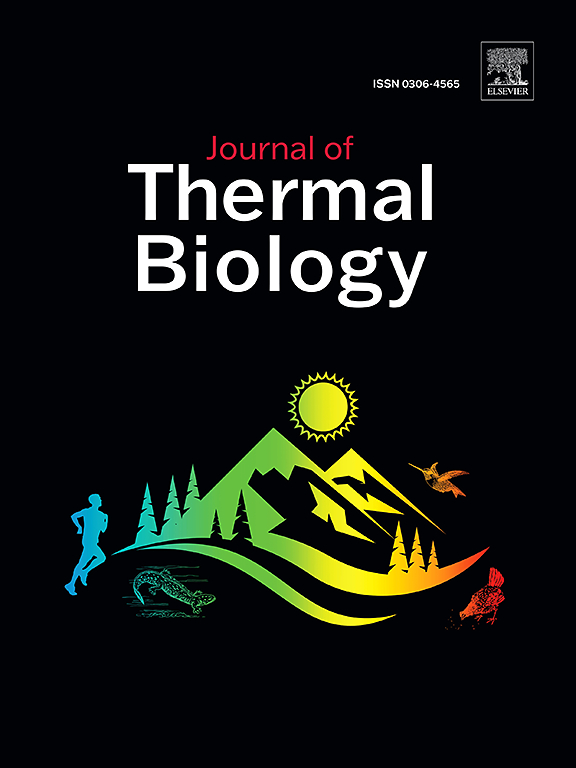Evaluating the physiological benefits of behavioral flexibility in chacma baboons (Papio ursinus) using a biophysical model
IF 2.9
2区 生物学
Q2 BIOLOGY
引用次数: 0
Abstract
As opportunistic generalists occupying a range of ecological niches, chacma baboons (Papio ursinus) are considered a highly flexible species of relatively low conservation priority. Underlying their ecological flexibility is a repertoire of behavioral strategies observed in response to ecological stressors. Although these strategies are relatively well-documented, we know very little about how they impact upon an individual’s thermal and energetic physiology, which can influence population-level reproductive potential in the face of climatic warming. Here, we used Niche Mapper™ to construct a biophysical model that integrates morphometric, autonomic, and behavioral inputs to predict the core body temperature of chacma baboons in response to varied microclimate conditions. The predictive integrity of the model was confirmed by comparing model outputs with the core body temperature of a free-living chacma baboon equipped with an intra-abdominal temperature-sensitive data logger. When behavioral thermoregulation was incorporated, our model predicted body temperature within 1.5 °C of the observed temperature for 94% of hours. Of the tested behavioral thermoregulatory responses, shade-seeking provided the greatest thermal benefit, reducing predicted core body temperature by an average of 0.9 °C during daytime hours. Evaporative heat-dissipation strategies (sweating or swimming) were also highly effective in circumventing hyperthermia in our modeled individual, with an average body temperature reduction of 0.6 °C. Our findings underscore the critical importance of behavioral thermoregulatory strategies coupled with access to essential microhabitat features, water and shade, to achieve homeothermy in a warming climate.
使用生物物理模型评估chacma狒狒(Papio ursinus)行为灵活性的生理益处。
作为占据一系列生态位的机会主义通才,恰马狒狒(Papio ursinus)被认为是一种高度灵活的物种,其保护优先级相对较低。其生态灵活性的基础是在应对生态压力时观察到的一系列行为策略。虽然这些策略的记录相对较多,但我们对它们如何影响个体的热能和能量生理机能却知之甚少,而这些生理机能会在气候变暖的情况下影响种群的繁殖潜力。在这里,我们使用 Niche Mapper™ 建立了一个生物物理模型,该模型综合了形态计量学、自律神经学和行为学输入,可预测查克马狒狒在不同小气候条件下的核心体温。通过将模型输出结果与装有腹内温度敏感数据记录器的自由生活的查克马狒狒的核心体温进行比较,证实了该模型的预测完整性。当纳入行为体温调节时,我们的模型在 94% 的时间内预测的体温与观察到的体温相差不超过 1.5 °C。在测试过的行为体温调节反应中,遮荫能提供最大的热效益,使白天的预测核心体温平均降低 0.9 °C。蒸发散热策略(出汗或游泳)对我们的模型个体规避高热也非常有效,平均体温降低了 0.6 °C。我们的研究结果强调了行为体温调节策略的重要性,同时也强调了在气候变暖的情况下,水和遮荫等必要的微生境特征对实现体温调节的重要性。
本文章由计算机程序翻译,如有差异,请以英文原文为准。
求助全文
约1分钟内获得全文
求助全文
来源期刊

Journal of thermal biology
生物-动物学
CiteScore
5.30
自引率
7.40%
发文量
196
审稿时长
14.5 weeks
期刊介绍:
The Journal of Thermal Biology publishes articles that advance our knowledge on the ways and mechanisms through which temperature affects man and animals. This includes studies of their responses to these effects and on the ecological consequences. Directly relevant to this theme are:
• The mechanisms of thermal limitation, heat and cold injury, and the resistance of organisms to extremes of temperature
• The mechanisms involved in acclimation, acclimatization and evolutionary adaptation to temperature
• Mechanisms underlying the patterns of hibernation, torpor, dormancy, aestivation and diapause
• Effects of temperature on reproduction and development, growth, ageing and life-span
• Studies on modelling heat transfer between organisms and their environment
• The contributions of temperature to effects of climate change on animal species and man
• Studies of conservation biology and physiology related to temperature
• Behavioural and physiological regulation of body temperature including its pathophysiology and fever
• Medical applications of hypo- and hyperthermia
Article types:
• Original articles
• Review articles
 求助内容:
求助内容: 应助结果提醒方式:
应助结果提醒方式:


